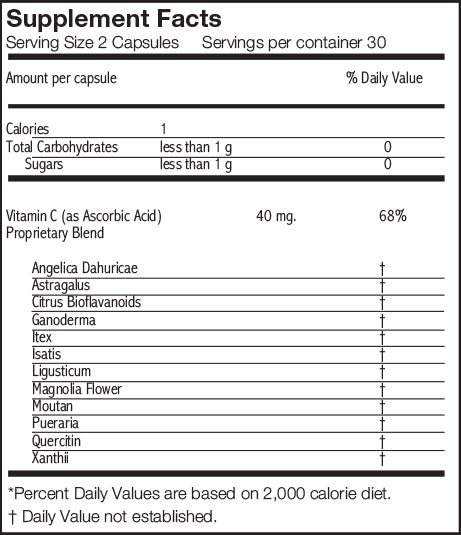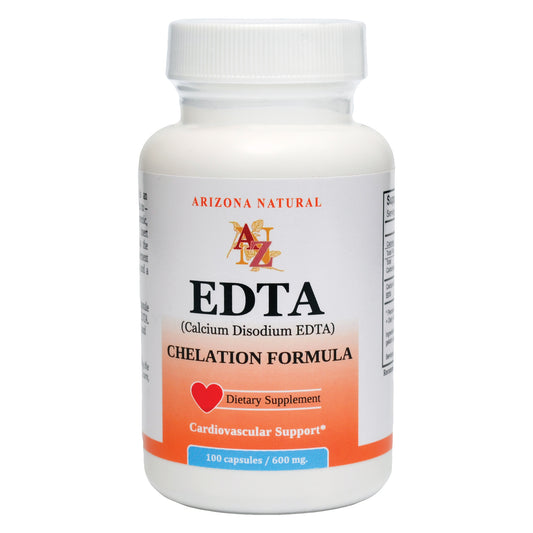EDTA Chelation and the Dangers of Heavy Metals
Share
EDTA Chelation Science and the Dangers of Heavy Metals
Understanding Chelation
Chelation is a biochemical process in which a chelating agent binds to metal ions, forming a stable complex that can be excreted from the body. This mechanism has profound implications in medicine, toxicology, and biochemistry, particularly in cases where excess or toxic metal accumulation poses health risks[1]. Chelating agents vary in their specificity, affinity, and application, with EDTA being one of the most well-known and studied examples[2]. Calcium disodium EDTA (CaNa2EDTA) is the form that is most used by health professionals because of its history of safe use and effective targeting of specific metals.
Mechanism of Action: How EDTA Chelates Metals
EDTA (ethylenediaminetetraacetic acid) is a hexadentate ligand, meaning it has six potential binding sites capable of coordinating with metal ions. When introduced into the body, EDTA binds with positively charged metal ions through its carboxyl and amine groups. The resulting metal-EDTA complex becomes more water-soluble and is subsequently excreted through the urinary system.
Why Calcium Disodium EDTA?
Among the various forms of EDTA, calcium disodium EDTA (CaNa2EDTA) is the preferred choice in clinical settings. This form is pre-saturated with calcium, which helps prevent it from depleting calcium from the body. Instead, it exhibits a higher affinity for toxic metals such as lead, cadmium, arsenic, mercury, and aluminum. Calcium disodium EDTA offers a more controlled and safer chelation experience, particularly in repeat or long-term protocols.
Toxic Effects of Heavy Metals on Health
Heavy metals such as lead, cadmium, arsenic, and mercury are among the most biologically disruptive environmental toxins. Though naturally occurring, their industrial use and accumulation in food, water, and air have made chronic exposure a global public health concern[6]. These metals exert their toxic effects through various mechanisms including oxidative stress, enzyme inhibition, membrane damage, and interference with essential mineral absorption.
What sets these elements apart from other toxins is their bioaccumulation—once inside the body, they can persist for years in bone, fat, organs, and the nervous system, often without immediate symptoms[11].
Individual Heavy Metals – Toxicology and Clinical Impact
Lead (Pb)
Sources: Contaminated water, old paint, industrial fumes, imported products.
Toxic Effects:
- Neurological Damage: Particularly harmful to developing brains in children; associated with reduced IQ, learning issues, and cognitive decline[3].
- Cardiovascular Strain: Correlated with increased blood pressure and arterial stiffness[4].
- Bone Storage: Can displace calcium and persist in bone tissue.
- Kidney Stress: Impaired renal function with chronic exposure[5].
Linked Conditions:
- Hypertension
- Cognitive decline and dementia
- Kidney disease
- Infertility and reproductive issues
Cadmium (Cd)
Sources: Industrial pollution, cigarette smoke, batteries, phosphate fertilizers.
Toxic Effects:
- Renal Toxicity: Accumulates in kidneys, impairing function[7].
- Skeletal Damage: Interferes with calcium metabolism, increasing fracture risk.
- Endocrine Disruption: Impacts insulin regulation and sex hormone balance.
- Carcinogenic Potential: Linked to cancers of the prostate, lung, and kidneys.
Linked Conditions:
- Osteoporosis and osteomalacia
- Chronic kidney disease
- Hormonal imbalances
- Various cancers
Arsenic (As)
Sources: Contaminated groundwater, industrial exposure, rice and other foods.
Toxic Effects:
- Cellular Damage: Induces oxidative stress and DNA damage.
- Cardiovascular Damage: Linked to ischemic heart disease and atherosclerosis[8].
- Neurotoxicity: Causes memory impairment, mood disorders, and neurodegeneration.
- Carcinogenicity: Associated with skin, bladder, and lung cancers[9].
Linked Conditions:
- Peripheral neuropathy
- Cardiovascular disease
- Diabetes mellitus
- Multiple cancers
Mercury (Hg)
Sources: Dental amalgams, contaminated fish, industrial emissions, broken thermometers and bulbs.
Toxic Effects:
- Neurotoxicity: Especially harmful in fetal development; linked to memory loss, tremors, and irritability[1].
- Immune Dysregulation: Can trigger or worsen autoimmune conditions[10].
- Renal Effects: Inorganic mercury accumulates in kidney tissue, impairing function.
Linked Conditions:
- Autism spectrum disorders (under investigation)
- Chronic fatigue and neurological syndromes
- Autoimmune thyroid disorders
- Mood disorders and tremors
Calcium Disodium EDTA in Clinical Practice
1. Treatment of Heavy Metal Toxicity
One of the most widely recognized medical uses of calcium disodium EDTA is in the treatment of heavy metal poisoning, especially lead toxicity. The compound has FDA approval for this indication and has been a mainstay in pediatric and adult cases involving elevated blood lead levels. Chelation therapy with CaNa2EDTA binds to the lead in the bloodstream and facilitates its excretion via the kidneys, thereby lowering the toxic burden.
2. Detoxification of Environmental and Occupational Exposures
Beyond acute poisoning, calcium disodium EDTA is commonly employed by integrative and environmental medicine practitioners for patients with chronic exposure to environmental toxins. This includes occupational exposure to cadmium, arsenic, and aluminum, which may accumulate over time and contribute to fatigue, cognitive impairment, immune dysfunction, and other chronic conditions. EDTA chelation is used in these cases to gradually reduce body burden and restore optimal physiological function.
3. Cardiovascular Chelation Therapy
Although more controversial and still under investigation, some practitioners use calcium disodium EDTA for cardiovascular chelation therapy. The rationale is that by reducing the total body burden of metals such as lead and cadmium—both of which are known to interfere with vascular health—patients may experience improvements in endothelial function and overall circulation. Some clinicians also report reductions in arterial plaque, inflammation, and oxidative stress. These uses are largely based on clinical trials, cohort studies, and patient-reported outcomes, although additional large-scale studies are ongoing to further clarify efficacy and safety.
Comparing EDTA Forms in Clinical Application
Disodium EDTA and calcium disodium EDTA differ significantly in their chelation profiles. Disodium EDTA is more aggressive and has been associated with hypocalcemia if administered improperly. For this reason, calcium disodium EDTA is the safer alternative in most therapeutic contexts. Its pre-saturation with calcium makes it selective for metals like lead and cadmium, reducing the risk of essential mineral depletion during therapy.
Conclusion
Heavy metals like lead, cadmium, arsenic, and mercury represent persistent, bio-accumulative threats with wide-ranging effects on the nervous, cardiovascular, skeletal, endocrine, and renal systems. For clinicians, understanding the impact of these metals is essential in treating chronic illness, preventing disease progression, and supporting detoxification efforts with chelation therapy.
Chelation using calcium disodium EDTA offers a scientifically supported and clinically validated approach for reducing toxic metal burden. With applications ranging from acute lead poisoning to chronic detoxification and even cardiovascular support, this chelating agent continues to play a vital role in integrative and environmental medicine. Understanding its mechanisms, safety profile, and therapeutic potential allows healthcare professionals to implement EDTA chelation responsibly and effectively within a well-monitored treatment protocol.
References
- Clarkson, T. W., & Magos, L. (2006). The toxicology of mercury and its chemical compounds. Critical Reviews in Toxicology, 36(8), 609–662. ↩︎
- Flora, S. J., Mittal, M., & Mehta, A. (2008). Heavy metal induced oxidative stress and its possible reversal by chelation therapy. Indian Journal of Medical Research, 128(4), 501. ↩︎
- Needleman, H. (2004). Lead poisoning. Annual Review of Medicine, 55, 209–222. ↩︎
- Navas-Acien, A., Guallar, E., Silbergeld, E. K., & Rothenberg, S. J. (2007). Lead exposure and cardiovascular disease—a systematic review. Environmental Health Perspectives, 115(3), 472–482. ↩︎
- Jurasović, J., Cvitković, P., Pizent, A., Colak, B., & Telisman, S. (2004). Semen quality and reproductive endocrine function in relation to biomarkers of lead, cadmium, zinc, and copper in men. Environmental Health Perspectives, 112(8), 870–878. ↩︎
- Jarup, L. (2003). Hazards of heavy metal contamination. British Medical Bulletin, 68(1), 167–182. ↩︎
- Järup, L., & Åkesson, A. (2009). Current status of cadmium as an environmental health problem. Toxicology and Applied Pharmacology, 238(3), 201–208. ↩︎
- States, J. C., Srivastava, S., Chen, Y., & Barchowsky, A. (2011). Arsenic and cardiovascular disease. Toxicological Sciences, 123(2), 368–375. ↩︎
- National Research Council (NRC). (2001). Arsenic in Drinking Water: 2001 Update. National Academies Press. ↩︎
- Silbergeld, E. K., Silva, I. A., & Nyland, J. F. (2005). Mercury and autoimmunity: implications for occupational and environmental health. Toxicology and Applied Pharmacology, 207(2), 282–292. ↩︎
- Patrick, L. (2006). Lead toxicity, a review of the literature. Part 1: Exposure, evaluation, and treatment. Alternative Medicine Review, 11(1), 2–22. ↩︎







